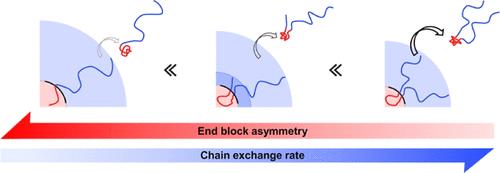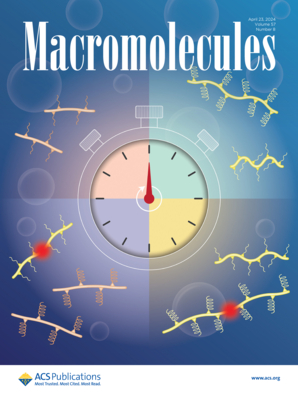Kinetics of Chain Exchange in Asymmetric ABA′ Triblock Polymer Micelles by Time-Resolved Small-Angle Neutron Scattering
IF 5.1
1区 化学
Q1 POLYMER SCIENCE
引用次数: 0
Abstract
The effect of corona block asymmetry on chain exchange kinetics has been investigated using time-resolved small-angle neutron scattering (TR-SANS) with a series of AB di- and ABA′ triblock micelles composed of poly(ethylene-alt-propylene) (A) and polystyrene (B) block copolymers in squalane. The four copolymers maintain constant molecular weight and total block composition, but have different asymmetry ratios of the end blocks, denoted as SEP, EPSEP′-1, EPSEP′-2, and EPSEP. The TR-SANS results reveal a 10-fold acceleration in the chain exchange rate for asymmetric triblock copolymer micelles (EPSEP′-1 and EPSEP′-2) and a hundred-fold acceleration for symmetric triblock copolymers (EPSEP), compared to the SEP diblock copolymer. This enhanced exchange rate is primarily attributed to differences in the micelle structure associated with corona chain entropy during extraction, supported by calculations of grafting chain density and stretching of corona chains. Thus, this study demonstrates an interesting and significant role of block copolymer asymmetry in molecular exchange dynamics.

通过时间分辨小角中子散射研究不对称 ABA′三嵌段聚合物胶束中的链交换动力学
利用时间分辨小角中子散射(TR-SANS)技术,对角鲨烷中一系列由聚(乙烯-邻苯二甲酸丙烯)(A)和聚苯乙烯(B)嵌段共聚物组成的 AB 二嵌段和 ABA′ 三嵌段胶束的电晕嵌段不对称性对链交换动力学的影响进行了研究。四种共聚物的分子量和总嵌段组成保持不变,但端嵌段的不对称比例不同,分别称为 SEP、EPSEP′-1、EPSEP′-2 和 EPSEP。TR-SANS 结果显示,与 SEP 二嵌段共聚物相比,不对称三嵌段共聚物胶束(EPSEP′-1 和 EPSEP′-2)的链交换速率加快了 10 倍,对称三嵌段共聚物(EPSEP)的链交换速率加快了 100 倍。这种交换率的提高主要归因于在萃取过程中与电晕链熵相关的胶束结构的差异,并得到接枝链密度和电晕链伸展计算的支持。因此,这项研究证明了嵌段共聚物的不对称性在分子交换动力学中有趣而重要的作用。
本文章由计算机程序翻译,如有差异,请以英文原文为准。
求助全文
约1分钟内获得全文
求助全文
来源期刊

Macromolecules
工程技术-高分子科学
CiteScore
9.30
自引率
16.40%
发文量
942
审稿时长
2 months
期刊介绍:
Macromolecules publishes original, fundamental, and impactful research on all aspects of polymer science. Topics of interest include synthesis (e.g., controlled polymerizations, polymerization catalysis, post polymerization modification, new monomer structures and polymer architectures, and polymerization mechanisms/kinetics analysis); phase behavior, thermodynamics, dynamic, and ordering/disordering phenomena (e.g., self-assembly, gelation, crystallization, solution/melt/solid-state characteristics); structure and properties (e.g., mechanical and rheological properties, surface/interfacial characteristics, electronic and transport properties); new state of the art characterization (e.g., spectroscopy, scattering, microscopy, rheology), simulation (e.g., Monte Carlo, molecular dynamics, multi-scale/coarse-grained modeling), and theoretical methods. Renewable/sustainable polymers, polymer networks, responsive polymers, electro-, magneto- and opto-active macromolecules, inorganic polymers, charge-transporting polymers (ion-containing, semiconducting, and conducting), nanostructured polymers, and polymer composites are also of interest. Typical papers published in Macromolecules showcase important and innovative concepts, experimental methods/observations, and theoretical/computational approaches that demonstrate a fundamental advance in the understanding of polymers.
 求助内容:
求助内容: 应助结果提醒方式:
应助结果提醒方式:


